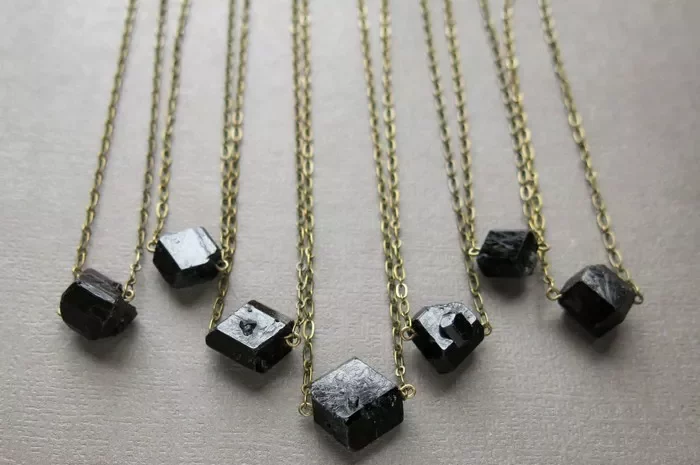Black tourmaline, also known as black电气石 or schorl, is a member of the tourmaline family, renowned for its distinctive black hue and unique properties. As a semi-precious gemstone, black tourmaline has been cherished for its protective energies and grounding abilities, making it a popular choice among jewelry enthusiasts and collectors. However, with the surge in demand, the market has also seen an influx of fake or treated stones. In this guide, we will delve into the world of black tourmaline, providing you with the knowledge and tools to distinguish authentic stones from their impostors. By understanding the characteristics, testing methods, and common imitations, you can ensure that your black tourmaline jewelry is both genuine and valuable.
Understanding Black Tourmaline
1. Composition and Formation
Black tourmaline belongs to the complex borosilicate minerals, with a chemical composition primarily consisting of sodium, aluminum, boron, silicon, oxygen, and trace elements like magnesium, iron, lithium, and potassium. Its formation is a result of hydrothermal activities within igneous and metamorphic rocks, often found in pegmatites and associated with granite intrusions.
2. Physical Properties
Color: Black tourmaline is predominantly black, though it can exhibit shades of brown or dark green depending on its iron content.
Hardness: With a hardness ranging from 6.5 to 7.5 on the Mohs scale, black tourmaline is relatively durable and scratch-resistant.
Optical Properties: It is usually transparent to translucent, with a vitreous to greasy luster. Some pieces may show cat’s-eye effects due to parallel inclusions.
Electrical Properties: Tourmaline is pyroelectric, meaning it generates electricity when heated, and piezoelectric, producing electricity under pressure.
Identifying Authentic Black Tourmaline
1. Visual Inspection
Color and Clarity: Authentic black tourmaline usually has a deep, uniform black color with possible variations due to natural inclusions. Avoid stones that are overly bright or have an unnatural shine, which may indicate dyeing or treatment.
Shape and Cut: Natural black tourmaline can come in various shapes and sizes, often with irregular edges. If the stone is perfectly cut and polished, it might have undergone extensive treatment or could be a synthetic imitation.
Inclusions: Look closely for natural inclusions like tiny crystals, fluid-filled cavities, or parallel needle-like structures. These are hallmarks of genuine black tourmaline.
2. Testing for Authenticity
Specific Gravity: Black tourmaline has a specific gravity of around 3.03 to 3.25. You can perform a simple density test by comparing the stone’s weight in water to its weight in air. While not definitive, this can help narrow down the possibilities.
Thermal Conductivity: Use a thermal conductivity tester to check if the stone is warm to the touch after being held in your hand for a few seconds. Black tourmaline is a relatively poor conductor of heat, so it should remain cooler than your skin.
UV Light Reaction: Under ultraviolet light, black tourmaline may exhibit a faint fluorescence, usually greenish-white or blue. However, this is not always consistent, and some natural stones may not react at all.
3. Advanced Testing
Refractometry: A refractometer can measure the refractive index of the stone, which for black tourmaline ranges from 1.62 to 1.68. This test requires precision and should be performed by a professional.
Spectroscopy: Infrared or Raman spectroscopy can analyze the stone’s molecular vibrations, providing definitive identification of its mineral composition.
Common Imitations and Treatments
1. Glass Imitations
Glass imitations are common in the gemstone market due to their low cost and ease of manufacturing. These imitations can be difficult to distinguish from natural stones, especially when they are well-crafted. Look for bubbles, flow lines, or an unnatural clarity that lacks the natural inclusions of black tourmaline.
2. Dyed Stones
Some black tourmaline may be dyed to enhance their color or cover up imperfections. Dyed stones often have a more uniform color and lack the depth and variations found in natural stones. Check for color concentration in cracks or along inclusions, which can indicate dyeing.
3. Heat-Treated Stones
Heat treatment is used to improve the clarity and color of certain gemstones. While not as common with black tourmaline, it’s important to be aware of this possibility. Heat-treated stones may show signs of cracking or a more uniform appearance.
4. Synthetic Tourmaline
Synthetic tourmaline, especially black tourmaline, is becoming increasingly sophisticated and difficult to distinguish from natural stones. These stones are grown in laboratories under controlled conditions and can exhibit similar physical properties. Advanced testing, such as spectroscopy, is often required to confirm authenticity.
Tips for Buying Authentic Black Tourmaline
1. Source Reputation
Buy from reputable dealers or jewelers with a proven track record of selling genuine gemstones. Research the seller’s credentials, customer reviews, and return policies before making a purchase.
2. Certification
Look for gemstone certification from independent laboratories like the Gemological Institute of America (GIA) or the American Gem Society (AGS). These certifications provide a detailed analysis of the stone’s properties and confirm its authenticity.
3. Ask Questions
Don’t be afraid to ask questions about the stone’s origin, treatment history, and any available testing results. A knowledgeable seller should be able to provide detailed information and answer your inquiries.
4. Compare Prices
Be wary of unusually low prices, as they may indicate a fake or treated stone. While pricing can vary based on quality and availability, a significantly lower price compared to market standards should raise suspicion.
Conclusion
Distinguishing authentic black tourmaline from its imitations requires a combination of visual inspection, advanced testing, and knowledge of common treatments and imitations. By understanding the unique properties and characteristics of black tourmaline, and by working with reputable sellers and relying on independent certifications, you can ensure that your black tourmaline jewelry is not only beautiful but also genuine. Remember, the true value of a gemstone lies not only in its appearance but also in its authenticity and the story it tells. So, take the time to learn, ask questions, and make informed decisions to add genuine black tourmaline to your collection.
Related topic:
- Why Is Tourmaline Different Colors?
- Is Green Tourmaline Expensive?
- What Are Some Interesting Facts About Pink Tourmaline?


